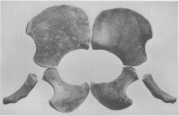| Leurospondylus Temporal range: Late Cretaceous, ~74–67 Ma PreꞒ Ꞓ O S D C P T J K Pg N | |
|---|---|
| Dorsal view of the holotype spine of L. ultimus | |
| Scientific classification | |
| Kingdom: | Animalia |
| Phylum: | Chordata |
| Class: | Sauropsida |
| Superorder: | Sauropterygia |
| Order: | †Plesiosauria |
| Suborder: | †Plesiosauroidea |
| Family: | †Elasmosauridae? |
| Genus: | †Leurospondylus Brown, 1913 |
| Binomial name | |
| †Leurospondylus ultimus Brown, 1913 | |
Leurospondylus is an extinct genus of plesiosaur from the Horseshoe Canyon Formation of Canada whose family is currently disputed, but is suggested to be Elasmosauridae.
Etymology
The name Leurospondylus comes from a fusion of two Greek words, leuros (λευρός) meaning "even", "flat" or "smooth", and spondylos (σπόνδυλος) meaning "vertebra." The specific name of the type species L. ultimus comes from the Latin ultimus meaning "last." It was so named because this genus was the latest known occurrence of a fossil plesiosaur when it was described in 1913."
Description


 Humeri (left), pelvis (middle), and coracoids (right) from the holotype
Humeri (left), pelvis (middle), and coracoids (right) from the holotype
The holotype of L. ultimus was a juvenile. The fossil included 12 vertebrae but the animal is thought to have had twice that number, and was estimated to be roughly 2 meters long as a juvenile. Samuel Paul Welles noted that the vertebrae are short and similar to those of pliosaurs, while the scapulae and coracoids bear resemblance to those of elasmosaurids, thus making it difficult to determine to which family it belongs. There is some speculation that the Leurospondylus specimen is either a juvenile of a known species, or in its own, unrecognized taxonomic group.
Distribution

The holotype was found in the brackish paleoenvironment represented by the Edmonton beds located on the present-day Red Deer River. This area is part of the Horseshoe Canyon Formation in Alberta, Canada. The occurrence of this juvenile fossil in an identifiably brackish environment led to the conclusion that plesiosaurs spent their early lives in rivers and estuaries. However, some plesiosaurs spent their adult lives in fresh water also; whether Leurospondylus grew up and then left, or grew up and stayed in a fresh water ecosystem has not been determined.
See also
References
- ^ "ppne.co.uk entry on Leurospondylus". Retrieved 2008-05-20.
- ^ "A new plesiosaur, Leurospondylus, from the Edmonton Cretaceous of Alberta". Bulletin of the AMNH; v. 32, article 40.
- ^ Welles, S. P. 1962. A new species of elasmosaur from the Aptian of Columbia and a review of the Cretaceous plesiosaurs. University of California Publications in Geological Science 46, 96 pp.
External links
- https://web.archive.org/web/20080703172817/http://www.plesiosaur.com/database/pdf/brown1913Leurospondylus.pdf
- http://www.ppne.co.uk/index.php?m=show&id=12527
| Taxon identifiers | |
|---|---|
| Leurospondylus |
|






